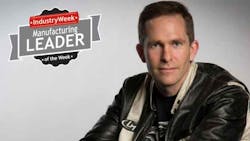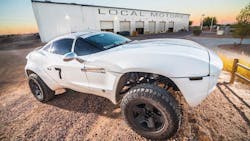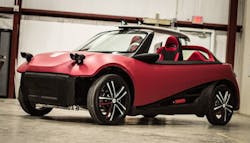Local Motors Revs Up Its 3-D Grand Plan
With his 3-D printed hotrods and a business model designed around Ikea-inspired microfactories, Local Motors CEO Jay Rogers is a wild child in automotive circles. But his bloodlines actually reach back to traditional manufacturing. “Building vehicles was in my history,” Rogers says. His grandfather, Ralph Burton Rogers, was an industrialist who ran Indian Motorcycles for 13 years (and tried to revive the brand with lighter bikes), before founding Texas Industries. Grandfather was also an altruist—he helped create the show Sesame Street and saved PBS from the government’s chopping block during the Nixon years.
The younger Rogers’ filial ties took on new meaning in the early 2000s, while he served in the Marine Corps. Living amid the harsh realities of an oil-rich society, “the abject poverty and unbelievable wealth,” he started thinking about how small, self-sufficient factories could change the energy and economic equations.“If you make vehicles locally, you’re giving sticky jobs that provide a middle class everywhere in the world,” Rogers says. “And everyone needs a vehicle. [Automotive] is such a ubiquitous industry that by distributing manufacturing, you all at once increase the innovation in a local area and create a middle class—and you decrease the dependency on this monolithic energy source of crude oil.”
When two of his compadres were killed in Iran in 2004, he decided he was ready for a different kind of action. “I had all this training, I had all these ideas I wanted to do, and I could end up dead or I could go out and give it a shot and try to make a difference,” he recalls.
He got on the fast track—Harvard Business School—and let no grass grow fine-tuning his idea for Local Motors, a car company built on low volume, open sourcing, and small, locally based factories. After winning a school business plan competition and a small amount of seed money, he managed to raise $4 million to start the company in 2008, with some of his initial investors coming from Harvard.
Headquartered in Phoenix, Local Motors now has about 160 employees and two microfactories, with another 45,000 square foot facility in Washington’s National Harbor set to open later this year.
What the company lacks in size it makes up for in buzz. It raised its profile several notches at the International Manufacturing Technology Show in Chicago in 2014, when it 3-D printed and assembled a car called the Strati on-site over two days. Also that year, it licensed its microfactory model to GE for its FirstBuild appliance facility in Louisville. And in January, Local Motors was the first recipient of investment money from Airbus’ venture capital fund, for drone development at its new lab in Berlin.
From DIY To 3-D
Initially, Rogers’ plan for Local Motors had more of a DIY aesthetic, one where car buyers would actually "turn a wrench" to build and customize their own cars in the microfactories. The facilities are visitor-friendly, being "more of a castle on a hill which is really attractive for people to visit--like a Bass Pro Shop or an Ikea, than a Detroit car factory,” says Rogers. Manufacturing and assembly line areas share digs with a showroom and an R&D space where prospective vehicle designers can try out crowdsourcing ideas.
The company’s first vehicle, a $99,900 muscle car/dune buggy mashup called the Rally Fighter, was the product of a design competition. It had a prepackaged engine and customers had to build half of it themselves at the company’s inaugural microfactory, in Chandler, Az. (the Rally Fighters are classified as kit cars because they are not federally crash-tested).
In 2014, Local Motors began the shift to a 3-D printed car with an additive manufacturing partnership with Oak Ridge National Laboratory in Knoxville. “I was taking stock of the business and saying ‘Really, how are we doing? How fast can we produce vehicles?’” says Rogers. “And there were still bumpy areas—making tubing for tubed steel, composite body panels—that were faster than other things in the automotive industry, but the quality and the speed weren’t where they needed to be.”3-D printing greatly cut down on the number of parts--and fewer parts meant fewer distribution channels, which matched well with the company’s “keep it local” aesthetic.
The engines changed, too. Initially, Local was “power train agnostic,” says Rogers. “If you had a great hybrid motor, if you had a great hydrogen or electric motor, it didn’t matter to us.”
But once 3-D printing became key, “We started to think, OK, what else can we do with the car to make it have fewer parts, and that’s where EVs really shine,” says Rogers.
Local Motors, which would not disclose its revenue, says it expects to start filling orders for its 3-D printed electric car in 2017. The company is partnering on the vehicle with IBM for IoT, Siemens for CAD modeling and SABIC for new materials. In January, it discontinued its biggest seller, a $1,199 motorized tricycle called the Verrado, to focus on its new direction.
The Woof Quotient
Rogers says that as the company goes forward, its goal is less customization than to be carve out a niche in niche vehicles. Local Motors' sweet spot is cars with a small but fiercely loyal audience, similar to the “Woof” version of the discontinued Honda Element, a dog-friendly car that had water bowls in the back and stink-resistant fabric.
“I cannot tell you we’re making a mass product that we’re customizing for everyone,” says Rogers. “In fact, we’re doing the opposite. We’re using our low-cost structure and our rapid ability to get to market to focus on the ‘woofs’ of the world.
“What we are hunting for is, ‘Oh, I like the locker lifestyle, I have a band, and this vehicle is perfect for my band lifestyle.' Or, ‘I’m a triathlete, I carry my bike, my swimsuits, my running shoes, they smell, they stink, theyr’e wet. I need to get from place to place and I need somewhere to stretch out my legs because they’re really cramped up.’”
The Rally Fighter, which Rogers describes as a “baha racer mixed with a highway vehicle” has its own niche, too. It says: “I live in Arizona, I like to go riding trails on the weekends and I can’t afford two cars and I want something I can drive to the supermarket and to take my kids to school, and I want to be able to go off road in it.”
The company recently crowdsourced a design for Swim, a 3-D printed prototype car designed for surfers and is also working on a neighborhood electric vehicle made for autonomous driving in highly congested cities.
“It can take eight people, or take cargo, and it is meant to have no driver. It is meant to be like a box so you can fit all of them together in a room if you’re storing them for charging at the end of the day,” says Rogers. “The wheels are out as far to the corners as possible so that standing and sitting is as flat and easy for pedestrians who are using this service.”
As the company grows, the plan is for the microfactories, which each employ around 200 people, to match the needs and strengths of the communities in which they’re located. “The Rally fighter is done out of Phoenix because there’s a desert,” says Rogers. “There’s a whole mess of people in Berlin who are specifically interested in drone technology. And Knoxville is where the major additive and materials sciences facility is.”
An ideal microfactory city has a population of over two million people within a three-hour driving radius. “Then we look for a university or laboratory partnership, where we can do research with people who are already doing great research,” says Rogers.
He rattles off a list of 20 cities around the world, places where the company has talked to economic development types about microfactories, from Kansas City to New York, to Dehli, Beijing and Johannesberg. Even Rwanda, which Rogers says has “really come out as a post-conflict country, and the president wants to attract investment,” is a possibility.
“I like to think of it as the finals of American Idol,” says Rogers of the selection process. “Whoever thought a singing competition would be attractive to a whole region? But as we get farther into it, we are seeing whole regions roll out for their hometown heroes.”
About the Author

Laura Putre
Senior Editor, IndustryWeek
As senior editor, Laura Putre works with IndustryWeek's editorial contributors and reports on leadership and the automotive industry as they relate to manufacturing. She joined IndustryWeek in 2015 as a staff writer covering workforce issues.
Prior to IndustryWeek, Laura reported on the healthcare industry and covered local news. She was the editor of the Chicago Journal and a staff writer for Cleveland Scene. Her national bylines include The Guardian, Slate, Pacific-Standard and The Root.
Laura was a National Press Foundation fellow in 2022.
Got a story idea? Reach out to Laura at [email protected]


